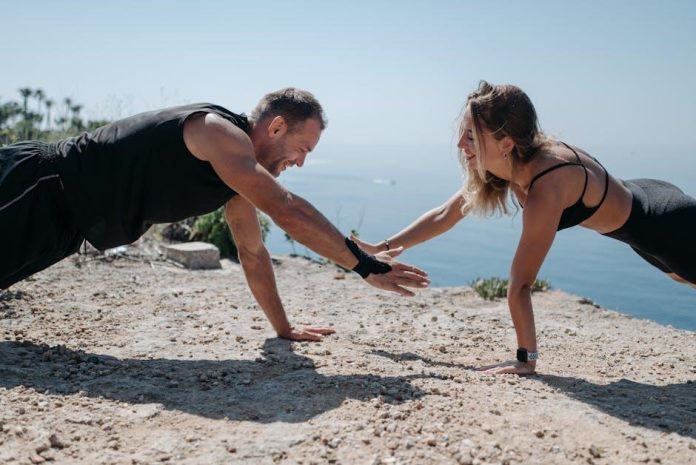In a world where screens dominate our daily lives and hours slip away while we remain hunched over keyboards, the silent suffering of poor posture has become a universal plight. From the boardroom to the living room, the way we hold ourselves speaks volumes—not just in terms of appearance, but in the subtle language of health and well-being. As we navigate the digital age, reclaiming control over our posture is more vital than ever. This article explores a collection of workouts designed to not only straighten your spine but to elevate your confidence and vitality. Join us as we delve into exercises that promise to transform your posture from a mere afterthought into a proud testament of strength and poise.
Strengthen Your Core for Better Posture
Engaging your core is more than just achieving toned abs; it’s about building a solid foundation for your entire body. A strong core acts like a central support system, helping to stabilize your spine and improve your overall balance. When your core muscles are robust, they support your back more effectively, leading to better posture and reduced strain on your spine. Consider incorporating these exercises into your routine to fortify your core:
- Planks: This classic exercise not only engages your abs but also strengthens your shoulders and back, promoting a more upright posture.
- Bird Dogs: Enhance your core stability by balancing on all fours, extending one arm and the opposite leg. This movement encourages spinal alignment and coordination.
- Russian Twists: Sit on the floor with knees bent, lean back slightly, and rotate your torso from side to side. This targets your obliques, which are crucial for rotational stability and maintaining an even posture.
- Dead Bugs: Lie on your back with arms extended towards the ceiling and legs in tabletop position. Slowly lower one arm and the opposite leg, keeping your back flat on the floor. This exercise improves your core control and spine support.
Incorporate these movements into your fitness routine to develop a more resilient core. As your core strength improves, you’ll notice a natural enhancement in your posture, leading to greater comfort and confidence in your daily activities.

Unlocking the Power of Stretching for Alignment
Stretching is more than just a prelude to a workout; it’s a powerful tool for achieving better alignment and enhancing your posture. Incorporating targeted stretches into your routine can help release tension, increase flexibility, and promote a balanced stance. Here are some key stretches to integrate into your daily life:
- Cat-Cow Stretch: This dynamic stretch helps improve spine flexibility and encourages a neutral alignment by gently moving between an arched and rounded back position.
- Child’s Pose: A restorative pose that stretches the back and hips, promoting relaxation and lengthening the spine.
- Standing Forward Bend: Helps in elongating the spine and releasing tension in the neck and shoulders.
- Chest Opener: By stretching the chest and shoulders, this move counteracts the effects of slouching and promotes an upright posture.
Integrating these stretches into your routine not only aids in correcting misalignments but also enhances your overall well-being by fostering a more mindful approach to body awareness. Remember to breathe deeply and move with intention to maximize the benefits.

Mindful Movement Techniques to Enhance Postural Awareness
Incorporating mindful movement techniques into your fitness routine can significantly enhance your awareness of body alignment and balance. These techniques focus on gentle, intentional movements that encourage the mind to connect deeply with the body, promoting better posture and overall well-being. Here are some effective strategies to consider:
- Yoga: With its emphasis on breath and balance, yoga offers a holistic approach to posture improvement. Poses like the Mountain and Tree can enhance your awareness of how you carry your body.
- Pilates: Known for its core-strengthening exercises, Pilates encourages spinal alignment and builds the muscles that support good posture. Moves like the Plank and Roll-Up are particularly beneficial.
- Alexander Technique: This technique teaches how to release unnecessary tension and find ease in movement, which can naturally lead to improved posture. It focuses on the relationship between head, neck, and spine.
These practices not only cultivate physical strength but also foster a mindful presence, allowing you to notice and adjust your posture throughout daily activities. By integrating these techniques, you can build a foundation for healthier, more conscious movement patterns.

Targeted Exercises to Correct Common Postural Issues
Addressing postural imbalances can be transformative, not just for aesthetics but for overall well-being. Here are some targeted exercises to help correct common postural issues:
- Rounded Shoulders: Strengthening the upper back can help. Try reverse flys and rows to open up your chest and pull your shoulders back into alignment.
- Forward Head Posture: Combat this with chin tucks and neck stretches. These exercises can realign your head over your shoulders, reducing strain on your neck.
- Anterior Pelvic Tilt: Engage in glute bridges and planks to strengthen your core and glutes, which helps in pulling your pelvis back into a neutral position.
Incorporating these exercises into your routine can gradually improve your posture, making everyday movements more comfortable and reducing the risk of long-term issues.
The Way Forward
As we stand at the close of our journey through the world of posture-improving workouts, it’s clear that the path to a more aligned and confident self is paved with mindful movement and intentional practice. Each exercise, from the gentle stretches that awaken dormant muscles to the strength-building routines that fortify your core, serves as a stepping stone toward a healthier posture and, ultimately, a healthier you.
Incorporating these workouts into your daily routine not only promises to elevate your physical well-being but also fosters a sense of empowerment and resilience. Remember, the key lies in consistency and patience, allowing your body the time it needs to adapt and transform.
As you step away from this article and into the rhythm of your life, carry with you the knowledge and inspiration to stand a little taller and move a little more freely. Let this be the beginning of a lifelong commitment to nurturing your body, honoring its form, and embracing the vitality that comes with good posture. Here’s to a future of standing strong and moving with grace.


































